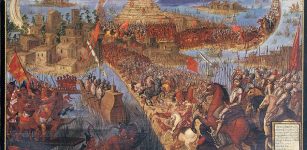On This Day In History: Terracotta Army Buried With Emperor Qin Shi Huang Discovered – On Mar 29, 1974
MessageToEagle.com – On March 29, 1974, local farmers in Lintong District, Xi’an, Shaanxi province, China, discovered the Terracotta Army that was buried with Qin Shi Huang, the first Emperor of China, in the third century BC.
While digging for a well nearby the royal tomb of the Qin Emperor’s tomb mound at Mount Li (Lishan), the farmers found a chamber containing a series of lifelike terracotta figures.
Archaeologists sent to the area, began excavations, which soon revealed the largest pottery figurine group ever found in China.
The collection, also known as the “Terracotta Warriors and Horses”, depicts the armies of Qin She Huang and was created to guard the emperor’s mausoleum from theft, exploration and accompany the emperor in his afterlife.
The figures of warriors and horses are arranged in battle formations. There are columns of soldiers at the front, followed by war chariots at the back.
They are replicas of what the imperial guard should look like in those days of power and splendor.
Today, the museum covers an area of 16,300 square meters, divided into three sections: No. 1 Pit, No. 2 Pit, and No. 3 Pit respectively. They were tagged in the order of their discoveries.
No. 1 Pit is the largest, first opened to the public on China’s National Day – Oct. 1st, 1979. Totally over 7,000 pottery soldiers, horses, chariots, and even weapons have been unearthed from these pits. Most of them have been restored to their former magnificence.
See also:
Mysterious History Of Qin Shi Huang – First Emperor Of China
Upon ascending the throne at the age of 13 (in 246 BC), Qin Shi Huang, later the first Emperor of all China, had begun to work for his mausoleum. It took 11 years to build the structure, which was the size of a small city.
Ancient records say that about 700,000 people were busy creating Qin Shi Huang’s burial site with the army of 8,000 soldiers, several hundred horsemen, and other terracotta figures of officials, musicians and acrobats.
It is speculated that a large number of sacrificial objects and other treasures had been also buried in the emperor’s tomb.
MessageToEagle.com
Expand for references













